| Back to the Plastic Scale
Modeling page
|
|
 |
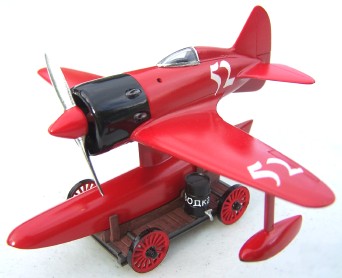 Polikarpov I-16 1949 Schneider Trophy Racer
Polikarpov I-16 1949 Schneider Trophy Racerby Michael Morrow In 2004, a special event was proposed for the Seattle IPMS 2005 Spring Show called the 1949 Schneider Trophy Race. The event rules required only the following: - Must be seaworthy (must appear to float unattended an extended period, and takeoff/land on water) - Must be airworthy (must appear to maneuver on the course and fly the race distance of approx. 683 km (425 miles) with pit stop(s) at entrant's discretion; no jettisonable equipment such as drop tanks, JATO/RATO bottles, etc. - Corporate sponsorship(s) acceptable (associated signage must be appropriate for era) Models must also meet the following requirements: - 1/72 scale (for the widest range of possibilities, lowest cost, most rapid construction) - Limited to 1940s or earlier technology - Include a history of the development and racing preparation of the prototype The choice of subject, nation, technology pilot, etc., is yours. 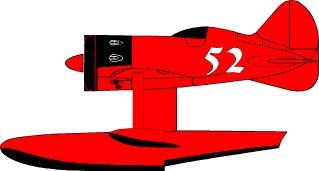 The event was enthusiastically received, and many models were built for this event. I decided that my entry was going to be a spare-parts box special, so I rummaged through my stash of kits and parts looking for a suitable candidate, and found a started-but-unfinished Polikarpov I-16, and a single float off an old Nichimo?? Aichi A6N1 seaplane. Several sketches were made, and I finally decided on an all-red racer with a gloss black cowl, and white race numbers.
The event was enthusiastically received, and many models were built for this event. I decided that my entry was going to be a spare-parts box special, so I rummaged through my stash of kits and parts looking for a suitable candidate, and found a started-but-unfinished Polikarpov I-16, and a single float off an old Nichimo?? Aichi A6N1 seaplane. Several sketches were made, and I finally decided on an all-red racer with a gloss black cowl, and white race numbers.The Build Construction The build started with the partially assembled Polikarpov I-16. The landing gear doors were glued in the retracted position, filled, and sanded smooth. A large ventral fin was added below the vertical tail, filled in, and sanded smooth. All the rib and fabric detail on the wings, stabilizer, and tail was also filled and sanded to reproduce smooth racer-like plywood-skinned surfaces. The model was primed, filled, and sanded several times until a smooth finish was achieved. Mounting pins were installed on the single main float and corresponding holes drilled in the fuselage. A hole for the auxiliary boil-off cooling system was drilled on the upper forward fuselage. 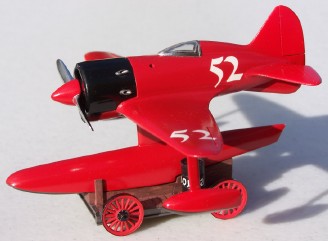 On the Revell I-16 kit, the cowl comes in three pieces so you can display the model with the engine visible. I glued all three pieces together, and sanded the cowl smooth. The gun ports were filled in, and the exhaust ports drilled out. All except three of the shutter sections on the front of the cowl were removed to aid engine cooling. The cowl was then painted a high-gloss black and set aside to dry. When it had thoroughly dried, short pieces of thin-walled plastic tubing from CONTRAIL MODEL AIRCRAFT (which I purchased long ago at a now-defunct hobby shop in California) were inserted in the exhaust ports to make the slightly extended exhaust stacks, which added to the impression of a racer with a big engine. The finished cowl was then set aside to await final assembly.
On the Revell I-16 kit, the cowl comes in three pieces so you can display the model with the engine visible. I glued all three pieces together, and sanded the cowl smooth. The gun ports were filled in, and the exhaust ports drilled out. All except three of the shutter sections on the front of the cowl were removed to aid engine cooling. The cowl was then painted a high-gloss black and set aside to dry. When it had thoroughly dried, short pieces of thin-walled plastic tubing from CONTRAIL MODEL AIRCRAFT (which I purchased long ago at a now-defunct hobby shop in California) were inserted in the exhaust ports to make the slightly extended exhaust stacks, which added to the impression of a racer with a big engine. The finished cowl was then set aside to await final assembly.I have no current source for Contrail Model Aircraft or their products, just an old address which may or may not be any good. Here it is anyway: |
|
Contrail Model Aircraft Sutcliffe Productions Westcombe, Shepton Mallet Somerset England |
 After much fruitless searching through various parts spares boxes, no tip floats were to be found. I finally broke down and made my own. A tip float was drawn up in CorelDraw, scaled to multiple sizes, printed out, and the most proportionate size was chosen for my model. A mold was carved, and four vacuum-formed halves were made, two of each side. The halves were trimmed, sanded, and glued together to produce two identical tip floats. A strip of styrene was sanded to an almost airfoil shape, from which two tip float struts were cut. The struts were slipped into the floats and glued in place.
After much fruitless searching through various parts spares boxes, no tip floats were to be found. I finally broke down and made my own. A tip float was drawn up in CorelDraw, scaled to multiple sizes, printed out, and the most proportionate size was chosen for my model. A mold was carved, and four vacuum-formed halves were made, two of each side. The halves were trimmed, sanded, and glued together to produce two identical tip floats. A strip of styrene was sanded to an almost airfoil shape, from which two tip float struts were cut. The struts were slipped into the floats and glued in place.With the tip floats finished, mounting holes were needed in the wings. Using a sharp #11 blade, strut mounting holes were very carefully cut in the bottom of the wings near the wingtips to match the tip float struts. The spare-parts-box prop originally came from an old Hawk Curtiss biplane seaplane racer. It's a large blade fixed pitch prop of the sort used on most Schneider Trophy racers before the war, so it looks the part. The prop diameter was trimmed a bit to clear the main float, and then the spinner received a coat of flat white, then Insignia Red. I used Bare-Metal Foil on the front of the prop blades to give them a polished metal look, and painted the backs of the blades flat black to keep from blinding the pilot. The spare-parts-box canopy was originally the back half of an old Revell Ki-84 Hayate canopy suitably trimmed to fit the turtle-deck of the I-16. Thin strips of Bare Metal foil were added to make the canopy frame. I was really pleased with how the simple addition of the canopy made the model really look the part of a racer. Painting Early on in the project, I had decided on a particular font that I wanted to use for the race numbers. I had no luck finding white race numbers anywhere near the style I wanted, so I decided to cut stencils out of Tamiya Yellow Tape, apply them over a flat white base coat, and then spray the final red color. Removing the tape would expose the white race numbers that I wanted. With this in mind, I sprayed the entire model (minus the cowl), the main float, and both tip floats flat white. 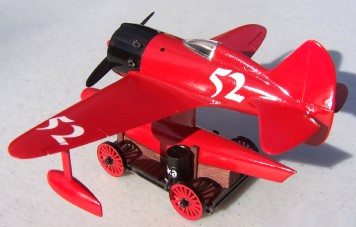 Several pieces of wide Tamiya Yellow Tape were stuck down on a smooth, clean, hard surface. The numbers were scaled to the 24 inch high size required in the rules using CorelDraw, printed out, and taped over the Tamiya Yellow Tape. They were then carefully cut out, lifted off, and applied to the model in the appropriate positions. The model was then sprayed overall with ModelMaster Insignia red paint and allowed to dry. The Yellow Tape numbers were very carefully removed using a very sharp #11 blade, and "Voila" - white race numbers that looked the way I wanted them to!
Several pieces of wide Tamiya Yellow Tape were stuck down on a smooth, clean, hard surface. The numbers were scaled to the 24 inch high size required in the rules using CorelDraw, printed out, and taped over the Tamiya Yellow Tape. They were then carefully cut out, lifted off, and applied to the model in the appropriate positions. The model was then sprayed overall with ModelMaster Insignia red paint and allowed to dry. The Yellow Tape numbers were very carefully removed using a very sharp #11 blade, and "Voila" - white race numbers that looked the way I wanted them to!With all the major components completed and painted, the parts were all given several coats of future to provide the requisite glossy raceplane finish. At this point in the project, I still hadn't been able to find a suitable engine for the racer. In the spirit of an unlimited racer, the standard M-62 nine-cylinder radial produced far too little horsepower, so I set about looking for an M-82FN 14-cylinder two-row engine with nearly double the horsepower to replace it. Many kits were examined to try and find a suitably accurate M82FN engine without success. Finally a request was made to the members of the NWSM group, and in short order, a link arrived via e-mail for an "Engines & Things" M82FN engine, which I promptly ordered. This turned out to be the only part I used on the model itself that didn't come from my spares box, and one of only two parts used on the whole project that didn't come from the spares box, but it was worth it. |
|
Engines & Things P.O. Box 48013 St. Albert, AB T8N 5V9 Canada |
|
When the engine arrived, a test fit revealed that the engine would have to be moved back quite a bit to fit inside the cowling. This would also be necessary to maintain the Center of Gravity in the real aircraft. Most of the stock Revell kit's engine mount was cut away so the engine would fit both lengthwise within the cowling, and centered so the prop shaft was centered in the hole in the front of the cowling. With the fit assured, the engine was painted, dry-brushed, and a propshaft hole was drilled into the front of the engine. With much fiddling, the completed engine was centered to fit inside the cowl and glued in place on the remains of the kit firewall. Final Assembly When the engine had dried, the cowl was glued to the fuselage. The main float was glued in place, and the model propped up to keep it centered while the glue dried. When the main float was dry, the tip floats were installed, adjusted to the proper angle, and glued in place. After allowing the tip floats to dry thoroughly, the canopy was positioned on the fuselage and it's outline carefully marked on the top of the fuselage. The canopy was removed, and the area within the outline was painted flat black. When the flat black had dried, the canopy was glued permanently in place. The prop was slipped into the propshaft hole in the engine, and the model was basically complete. 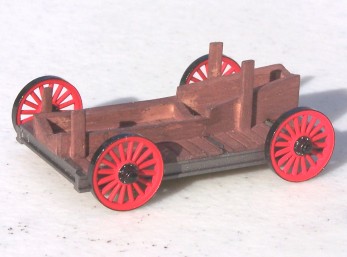 The Launching Dolly
The Launching DollyI wanted to display the model on a launching dolly, so I looked through several books on Golden Age racers, and discovered that most seaplane launching dollies were very crude affairs assembled out of what appeared to be scrap wood and spare wheels. The wheels ranged from all-metal types that looked to have been liberated from rail cars, to solid-wood wheels constructed out of wood blocks, to wire-spoke wheels of the type used on WWI aircraft, to wheels that looked suspiciously like they had been stolen off an old Conestoga wagon. I searched through a variety of model train shops looking for suitable wheels, and was about to give up, when I found some HO scale circus wagon wheels that looked perfect for the task. With these little treasures in hand (the only other parts that didn't come from my spares boxes), I set about making a launching dolly. I wanted the launching dolly to appear crude, and to have been made from parts at hand. The frame was made from plastic scale I-beams, and painted to look like metal. The basic frame structure was covered with thin balsa strips, and the float support was cut from pieces of balsa sheet cut to match the profile of the float bottoms with cross pieces cut to match the cross-section of the float bottoms. The balsa pieces were all given a coat of flat roof brown paint to simulate old wood. The wheels were given a coat of flat white, followed by Insignia Red. When they were dry, the metal hoops and hubs were painted gloss black. Axles were cut to length, the wheels installed on them, and small pins inserted in the ends of the axles to simulate wheel hubs and to hold the wheels in place. Further examination of pictures of old dollies showed that there were usually uprights on the float support to keep the float vertical, so four uprights, two at the front and two at the back were glued in place and painted to match the rest of the wood parts. 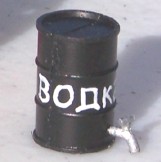 After all the paint on the dolly had dried, the main float of the model was carefully slipped between the float support uprights and slid into place. The model was now complete, but by a fortuitous accident, a 55-gallon oil drum was found in approximately the right scale. A spigot was quickly constructed from plastic rod and glued in place at the bottom of the drum. The drum was painted black, and the spigot silver. Perusal of a Lonely Planet Travel Guide for the USSR netted a Russian alphabet reference, and the word "VODKA" was crudely lettered on the side of the 55-gallon drum. The drum was placed on the side of the launching dolly, and the model was finally finished.
After all the paint on the dolly had dried, the main float of the model was carefully slipped between the float support uprights and slid into place. The model was now complete, but by a fortuitous accident, a 55-gallon oil drum was found in approximately the right scale. A spigot was quickly constructed from plastic rod and glued in place at the bottom of the drum. The drum was painted black, and the spigot silver. Perusal of a Lonely Planet Travel Guide for the USSR netted a Russian alphabet reference, and the word "VODKA" was crudely lettered on the side of the 55-gallon drum. The drum was placed on the side of the launching dolly, and the model was finally finished.With the model complete, the task of writing the aircraft "Development History and racing Preparation" was started. Amazingly enough, the development history article was completed almost entirely in one sitting, with only a few minor corrections needed after the fact. Here for your amusement then, is the "Polikarpov I-16 1949 Schneider Trophy Racer Development and Race History" article. Polikarpov I-16 1949 Schneider Trophy Racer Development and Race History When it was announced in 1949 that the Schneider Trophy Races were to be restarted, some members of the Russian Air Force were very excited. Here was an opportunity to showcase to the world the finest in Russian Engineering. An excited group of engineers and airmen presented their proposal for a Schneider Trophy Race entry to the leaders of the Russian Government. Expecting a quick approval, they were stunned to find out that the government not only disapproved, but disapproved strongly with the idea of entering a competition with any of the decadent bourgeoisie western governments, much less all of them at once. Not only were they told there would be no official entry, they were also denied access to any front line aircraft as a basis of an entry. A thoroughly disappointed group returned to their makeshift Schneider Race headquarters, a deserted railway building on the Black Sea. While commiserating over a 55 gallon barrel of Vodka, someone pointed out that they had only been denied official entry, and that while front line aircraft were off limits, there were plenty of wrecked Russian aircraft littered across the countryside over a wide front courtesy of the Finnish Fighter Group LeLv. 24's Brewster B-239s, and German fighter groups JG's 3, 51, 52, 53, 54, and 77's Me-109s and FW-190s. The discussion turned to what could be achieved within the limits of their meager resources, and it was decided to use the smallest possible aircraft married to the biggest engine they could squeeze into it perched on a single float to minimize drag. Thus was born the unofficial Russian Polikarpov I-16 Schneider Trophy Race entry. The tear-down and rebuilding of the I-16 began immediately. Due to battle damage the M-62 engine was junk, but a larger engine was needed anyway, and another Guns and landing gear were removed during the lightening process, and tanks for the alcohol were installed in the empty landing gear bays. In an effort to improve streamlining and reduce drag, the entire wing and all the tail surfaces were stripped of fabric. With the structure exposed, the main spars were strengthened so they could meet the much higher load requirements of the racer. The wings and tail surfaces were then sheeted with several layers of thin plywood, which was sanded smooth, and finished to a fine gloss in Soviet Red. Anticipating a much higher speed from their hot-rod aircraft, the ailerons were reduced in size to prevent over-control of the aircraft. The additional horsepower would require more directional stability, so a large ventral fin was added below the tail. Word filtered back that a Japanese seaplane base had been captured on the Japanese front at the end of the war. After some research, an exploratory trip, and suitable discussions with the seaplane base occupation team, several floats were appropriated in the dark of the night and shipped by rail car to the Schneider Race team, whereupon the rail car was returned to the seaplane base per the agreement carrying large quantities of Vodka, food stuffs, western style nylon stockings, and several crates of chocolate and Coca-Cola. With all the necessary parts of the aircraft now in place, building and testing moved at a rapid pace. Old pictures of pre-war Italian race planes brought to light the need for a suitable propeller, and after much eyeballing and guess work, a fixed high pitch metal prop was fabricated that was the biggest they could fit to the aircraft without hitting the main float. A spinner was fitted, and the aft side of the prop painted flat black to keep from blinding the pilot. For the high speeds envisioned, a canopy would be necessary. After much fruitless searching, a conversation with one of the seaplane base occupation members brought to light a crashed Ki-84 Hayate. Approximate dimensions were compared, and it was suggested that when the aft part of the Ki-84 fighter canopy was turned around backwards, it might fit the existing turtle deck of the I-16 quite nicely if appropriately trimmed. Another crate of foodstuffs and Vodka were dispatched, and shortly afterward, the aft section of the Ki-84 canopy arrived. It was indeed a good fit, so it was trimmed to size and fitted over the cockpit, resulting in a substantially cleaner aircraft. As the racer neared completion, it was time to fit the main float. Increased fuel and alcohol capacity would be needed due to the bigger engine's thirsty appetite, so fuel cells were installed in the main float and a small pump installed to pump them up to the engine. With a full load, it was estimated that the racer would have a nearly 1500 mile range! Tip floats were fabricated by the age-old method of eyeball engineering and fitted to the strengthened wing spars. Painting and finishing the floats brought the construction phase of the little hot-rod to completion. Team efforts now turned to flight testing. Pilot selection would be difficult, because no Russian pilot had ever flown a seaplane before, and this was not just any old seaplane. Engine tests had shown a significant torque affect, and it was clear the little racer would be a handful even for the most experienced of pilots. After considerable debate, and not a few heated discussions, a pilot was chosen. Taxi tests commenced, and the pilot slowly worked his way up to speed until he was comfortable with the aircraft on the float step. After making sure the engine was performing as expected, the time came for the first full test flight. The pilot gunned the engine, made a smooth takeoff, circled several times, and brought the little racer in for a successful landing. Much vodka was consumed that night in celebration. Late the following morning, after everyone had stumbled out of bed, the pilot mentioned that the aircraft had not been tested with a full load of fuel, and that it would probably be a good idea to do so to check the weight, balance, and trim of the aircraft at full gross weight. With the race only a few days away, the aircraft was fully fueled, and the pilot climbed aboard for the last test. The canopy was fastened closed, and with a snort, the engine started, and the pilot turned the little racer into the wind. The engine roared to full power, and the little racer leaped into the air, climbed rapidly away, turned west, and soon disappeared from sight. Russian fighters practicing over a nearby Russian base gave chase to the unexpected intruder, but the speedy little racer performed beyond all expectations. The pursuing Russian pilots could only watch in amazement as the little racer climbed rapidly away from them. They reported that it was last seen headed over the mountains of Greece. The little racer was never to be seen again, and so ended the unofficial Russian Schneider Trophy Race team's dreams of entering the 1949 Schneider Trophy Race. Several months later, one of the team members got a postcard featuring a bikini-clad bathing beauty with the words "Wishing You Were Here" emblazoned across the top of the card. It was post-marked Monaco, but on the back, the pilot had written to let them know that by selling off parts of the racer and using some money he had spirited away from the paymaster, he had acquired a small villa in the south of France, and was now on his way to visit the lake district in Northern Italy. Another card arrived at Christmas, and this one had an actual picture, featuring the pilot and a bathing beauty not much different than the one featured on the first card, with a short note on the back indicating that he and his new bride were settling down in his villa and starting a family, and that was the last they ever heard from him.
|